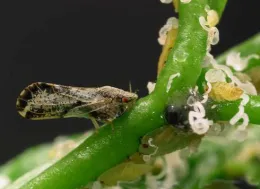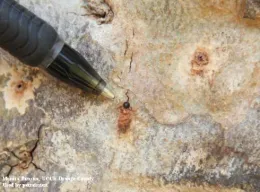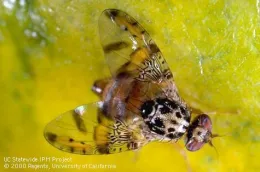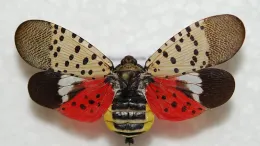Invasive Pests and Quarantines
Invasive pests are an ongoing problem in California. This page highlights the pests currently of concern in Santa Clara County, discusses the measures being taken, and lets home gardeners know what they can do and where to find more information.
There are currently two quarantines in effect in Santa Clara County. Following quarantine guidelines is particularly important to help contain pests and prevent them from spreading further.
Don't Pack a Pest
Many invasive species are unintentionally introduced by travelers or illegal importers bringing fruit or other products into the country. Be sure to follow the Don't Pack a Pest guidelines when you travel.
Invasive Pests
- Asian citrus psyllid Quarantine
- Guava Fruit Fly
- Invasive Shothole Borers (ISHB)
- Mediterranean Fruit Fly (Medfly) Quarantine
- Spotted Lanternfly
Asian citrus psyllid — Quarantine
County-wide quarantine on citrus fruits, leaves, and trees; also Indian curry leaf and other hosts

The Asian citrus psyllid (ACP) has been detected in Santa Clara County as well as other parts of California. This insect pest can carry the disease huanglongbing (HLB) that is devastating for all citrus trees. Efforts are focused on slowing the spread of this insect as much as possible. The disease has not yet been found in Northern California but has been detected in Southern California and other parts of the country. Much of California, including Santa Clara County, is under quarantine for the ACP insect.
Indian curry leaf (Murraya koenigii) can also host this insect, so it's included in the quarantine as well. See a list of all possible hosts.
The UC IPM Quick Tips on the Asian Citrus Psyllid explains the relationship between the Asian citrus psyllid (ACP) and the HLB disease, how to recognize the different stages of the ACP insect how the HLB disease affects citrus and the many ways that the insect can accidentally be transported into California. See also Residential ACP Management Strategy for more details and photos.
If you think your tree has HLB or if you find the Asian citrus psyllid, call the California Department of Food and Agriculture (CDFA) Exotic Pest Hotline at 1-800-491-1899 to confirm a find.
What the Asian citrus psyllid quarantine means
If you're trying to figure out what the quarantine means to use, follow these guidelines.
Clean fruits can be moved out of the quarantine zone
Homegrown citrus fruit totaling less than 25 pounds and that is clean of all stem and leaf material can be moved out of the quarantine area. Washing the fruit is a good extra precaution to take.
Plants and fruit can be moved within the quarantine zone
Plant material (whole plants, leaves) from backyard citrus or curry leaf plants may be transported within the quarantine area.
Plants can NOT be moved out of the quarantine zone
Plant material other than fruit (whole plants, leaves) from backyard citrus or curry leaf plants can NOT be transported out of the area. However, it CAN be put into local green waste collection.
Guava Fruit Fly

The invasive guava fruit fly has been detected in San Jose, prompting the CDFA to launch an eradication program running through at least May 17, 2026. While this is currently a treatment effort rather than a quarantine, a quarantine could be declared if more insects are found. Information about the treatment program and map can be found on the Santa Clara County Division of Agriculture's website. The CDFA Guava Fruit Fly Project web page has links to a full pest profile and a partial host list.
Invasive Shothole Borers (ISHB)

Invasive shothole borers (ISHB), a new insect pest, have been found in San Jose and in neighboring San Mateo and Santa Cruz counties. They attack hundreds of species of plants and are known to kill at least seventeen types of trees. The ISHB Pest Note includes identification and management information. The ISHB website has an introductory video, maps, and more.
Mediterranean Fruit Fly (Medfly) — Quarantine

Quarantine on most fruits and many vegetables
The Mediterranean Fruit Fly has been detected in San Jose. A large part of San Jose, as well as sections of Campbell, Los Gatos, Milpitas, and Santa Clara, are under quarantine for this pest (see map or check your address).
Medfly is a destructive insect pest that attacks more than 250 kinds of fruits, nuts, and vegetables. If Medflies become established in California, they could devastate both commercial production and home gardens, making produce difficult to grow and expensive to buy.
A major concern is that Medfly eggs and larvae can hitchhike to new areas on fruits and vegetables. To prevent accidentally spreading them, here's what home gardeners can do.
If you are in an established quarantine area
To prevent the spread of Mediterranean flies, residents are urged not to move vegetables, fruits, or nuts from their property.
DO
- Avoid potentially spreading eggs or larvae on fruits or vegetables by consuming or processing them on the property where they were grown.
- Examples of processing include cooking, juicing, freezing, dehydrating, and grinding in a garbage disposal.
- Processed food may be shared with others, including outside the quarantine zone.
- Eliminate potential breeding areas by harvesting all mature produce and picking up any that has fallen to the ground.
- Dispose of any unwanted produce by sealing it in a bag and place it in the regular waste bin, not the green waste bins.
DO NOT
- Do not share unprocessed fruits and vegetables with others.
- Do not compost fruits and vegetables at home.
- Do not leave mature fruits or vegetables on the plant.
- Do not leave fallen fruit on the ground.
- Do not put fruits and vegetables in municipal green waste.
- Do not move soil from your property.
Community gardens
Fruits and vegetables can be consumed on-site at the garden or taken home for personal consumption or processing. They may NOT be given away or sold to neighbors, friends, relatives, or customers unless processed (as noted above).
If you reside outside of a quarantine area
Do not move homegrown fruit, vegetables, or soil through the quarantine area, across the state, out of state, or across international borders.
Additional resources
- Mediterranean fruit fly host list
- CDFA Medfly brochure
- CDFA pest profile
- CDFA residential fact sheet
- CDFA Invasive Fruit Fly Quarantines in California
Spotted Lanternfly

The spotted lanternfly is an invasive pest that poses a significant threat to California gardens and landscapes. It is currently established in mid-Atlantic states, with the potential to invade California. This sap-sucking insect feeds on many plants, causing oozing sap, wilting, dieback, and plant death. Early detection is crucial, so the University of California and the CDFA encourage gardeners to learn how to identify it, and to report sightings to the CDFA Pest Hotline. Visit the UC Spotted Lanternfly website for more information.
Last updated: September 2025
